Phase 2: On the way to Base Camp
This phase encompassed our journey from HMI campus in west Bengal to HMI base camp in West Sikkim. It was a 5 day log journey where on day 9 we crossed over to West Sikkim, some 90-100 kms away, started trekking from day 10, acclimatized for a day thereafter and again resumed our 2 day long trek, reaching base camp on day 13th.
Day 9 was the day of leisure, as all that was required of us was just to hop onto the vehicle and move with it; no PT no climbing nothing, just one harmless Fall in. We started the journey somewhere between 7-8 am. The seating was mostly rope wise but for arrangement’s sake the last groups had to be disintegrated, and ours being the second last one had to face the turmoil. I was quite skeptical about it earlier but that soon evaporated to thin air as soon as I took my position inside. It was a bumpy ride for the larger part till we reached Sikkim, but the tranquil tea gardens and lush greenery kept my spirit Hale and hearty .

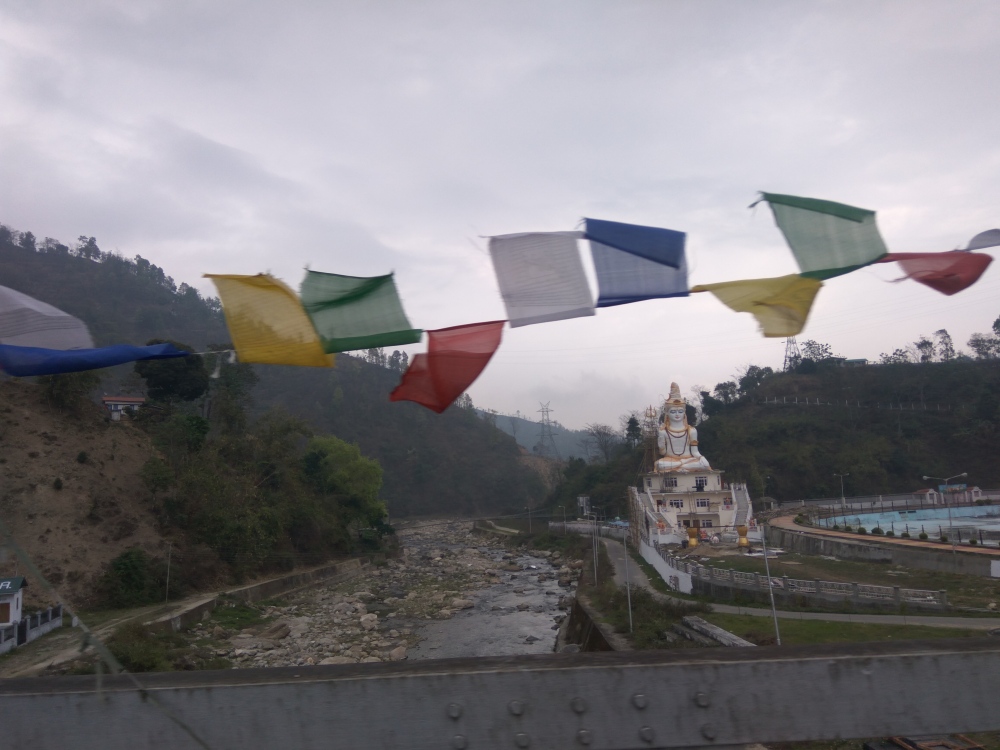
The two states are separated by Rangpo river and the bridge running over the river is from where you crossover to the other state.

After few hours of journey I was craving for food and when we halted at this place called Legship I ran towards the food and got to eat some momos with this amazing home made Sikkim delicacy called cheese ki chutney. The chutney, orangish in colour and thick liquidy in consistency was a tingling mix of spices perfectly blended with rich n creamy cheese. I can still remember the tangy n sour flavour that it flaunted. Sadly I don’t remember the restaurant’s name and all I can remember is a pink building where we followed all instructors, putting our trust on their discretion.
Post that it was a smooth ride till Yuksum, the place for our stay. As we were about to reach, the surroundings just got a shade or two more beautiful.
Yuksum is a small village situated at a height of around 5850 ft and was Sikkim’s capital around 1641 AD. The name literally means “meeting place of 3 Lamas” as it was established by these three Lamas. The place acts as starting point for Goechala trek as well. We had reached around 2-3 pm and had enough time in our hands till the dinner time. This meant I had some decent amount of time for exploration. The weather was a bit drizzly but we nevertheless decided to amble towards the market. Rather than taking the main route we started walking where ever we found a way. It was as if the road was calling us and we kept following.
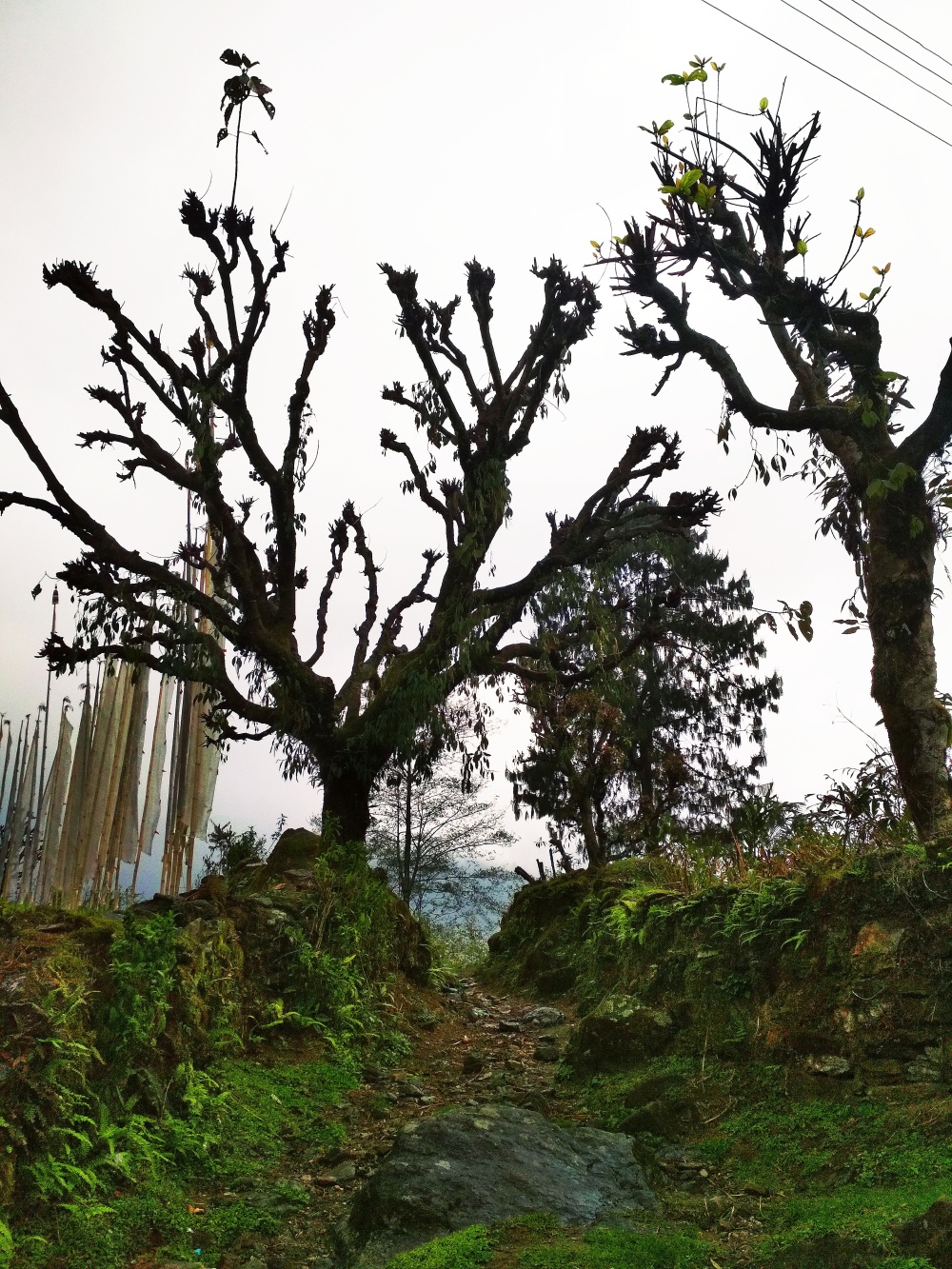
From a distance we could hear the soothing Buddhist chant and coudn’t contain ourselves from exploring it further. The chant we heard was coming out from a hut along the path. One could have easily meditated to the music of it and mysticism of the surroundings. We found out that the chant was not a recorded one, but was actually being sung by a person. Couldn’t gather much details as we were not able to understand each other’s language. From there we moved on further and came to know that the route led to market. So we ended up in market in search of our daily dose of coffee. There coincidentally I met with my trek mate from Chanderkhani pass trek who was on his way back from Goechala. Beauty of being a trekker – that of all the places we end up colliding with known faces at places like these.
The sun had started to set when we started to walk back and this gave us chance to spot some amazing cottages and accommodations which were lost to our eyes in the daylight. On reaching, we had dinner and later settled down to sleep in our tented accommodation. We were 12 people in one tent and I ended up sleeping with pile of shoes giving me company for the night on my one side. But the rotting smell did not deter my determination to sleep and I successfully was able to get a sound sleep.
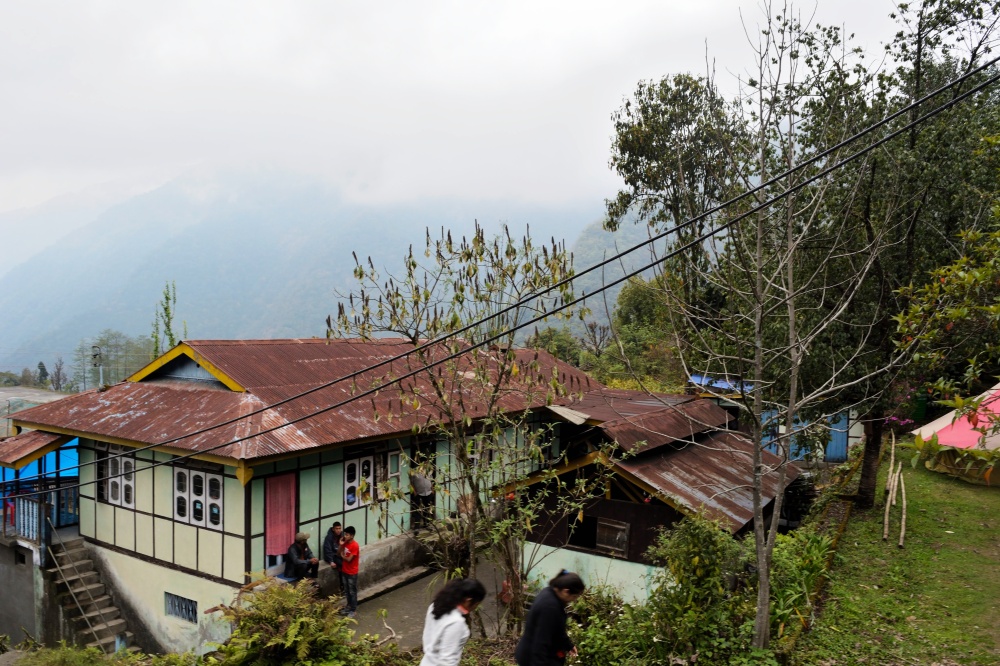
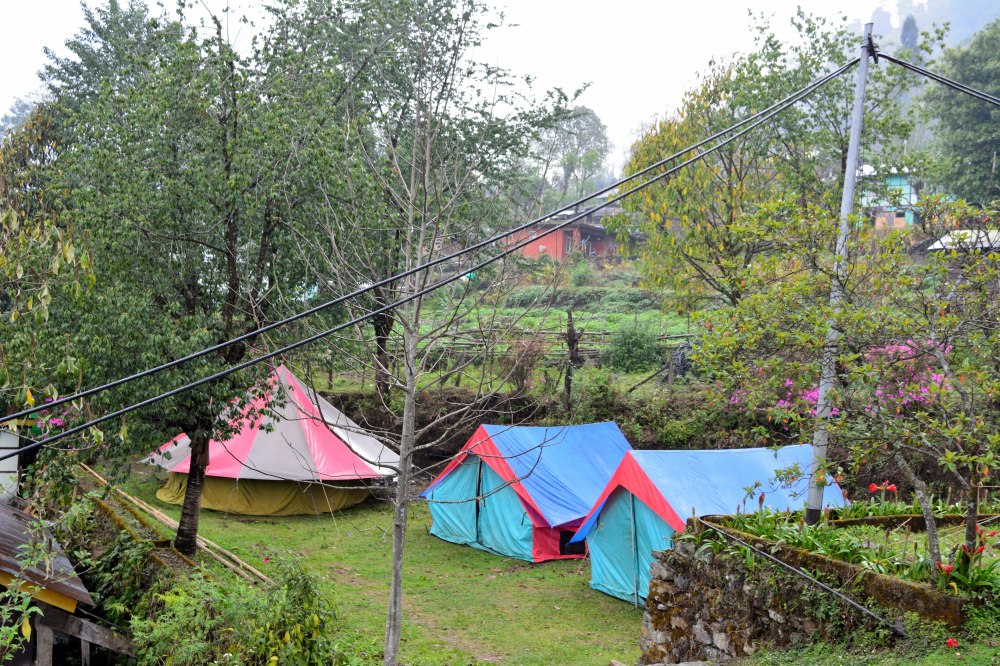
On the morning of Day 10, we commenced our journey towards the base camp. We had to cover a distance of 18 km and an altitude of 4000 ft till Tshoka, our next halt. With this much distance to cover, that too uphill, with that heavy rucksacks of ours was needless to say a lot frightening. But as it’s said “a journey of 1000 miles start from a single step”, we all started the trek in our best spirits. The trail started with a small walk downhill through a village and takes us to the first bridge. Somewhere here we enter the Khangchendzonga National Park.
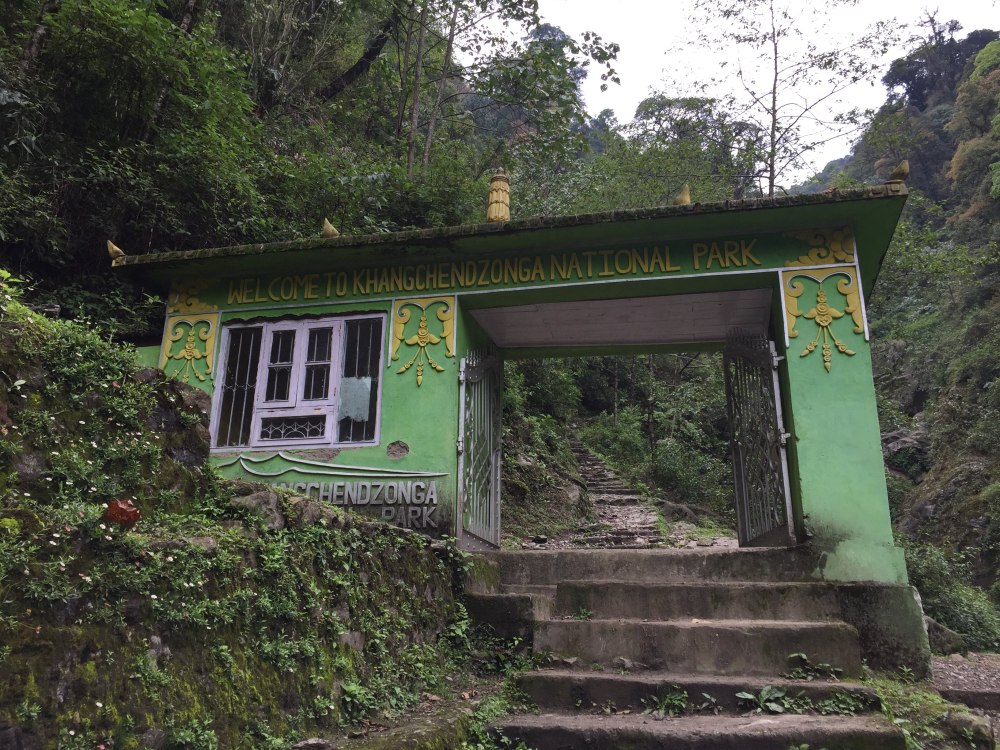
I could spot some berry laden plants while passing but I am not sure if all of them were edible. We saw a number of trekkers on the way as the same route goes towards Goechala. The initial downhill trail helps in building the momentum and warms up the body for upcoming uphill trail. After the bridge the route is a mixture of uphill and downhill trail, uphill being more dominant, till the fourth bridge called as Perekchu bridge. Here we took our last official halt for the day.

From there till Tshoka the route was completely uphill and that’s where it started getting on my nerves. We already had walked a good distance and now had to walk all the way uphill with the big rucksack. By this time my motivation had really gone down and even the beauty of the trail cloud not help it. But then we reached Bakhim and once again I was bowled over by the place. I forgot all my sufferings and just sat down for a while. I could see the white magnolia trees spread all over, with birds flying around it, splintering through thin layer of mist. Bakhim has a forest cover of oak, Birch , magnolia and Bamboo and attracts plenty of birds. The sight rejuvenated me and I resumed the trek with new energy. Tshoka was some 2 km far from there but as it was all the way uphill it took considerable time. Just before the place of stay, the route suddenly took a breathtaking transformation from lush green backdrop to blazing red. Red rhododendrons entirely dominated the field of our vision and our hearts. I wished I could spend more some time basking in the unabashed glory of those rhododendrons.

But we had to move and I finally reached the destination at around 3 o’clock.
Tshoka is a village in Khangchendzonga National Park with green meadows and white magnolias to be seen all around. Tshoka literally translates to “ source of water” and is called so because of the holy lake here that acts as a water source. A number of wooden cottages could be spotted, meant to accommodate trekkers mostly going to Dzongri La or Goechala trek. We were also given accommodation in wooden cottages where we were 12-15 people in the room with our mats and sleeping bags strewn over the floor. Getting to stay in a wooden cottage in the mountains, even though in such a crammed up manner was a luxury in itself. The bonus was the music that was being played by a group of trekkers who were staying next to our room for the night. Whatever weariness was left in me was gone by now and again I was on my exploration spree.

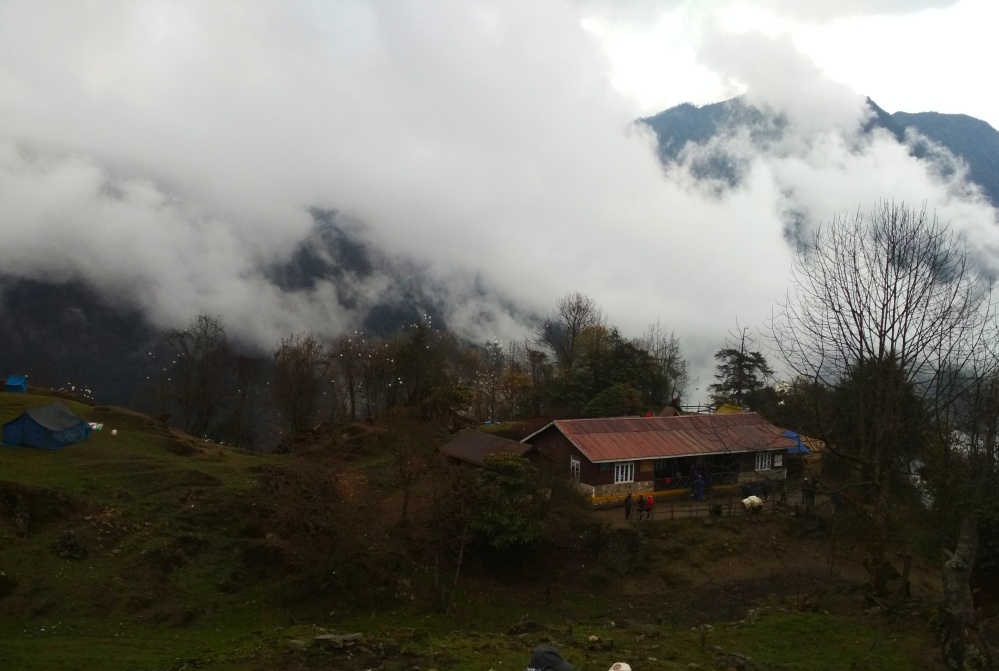
The temperature had started to drop drastically by now and suddenly we saw a glimpse of fire somewhere in a separate cottage. With hopes of finding a bonfire arrangement we scampered towards the place, only to find that it was a kitchen and that we weren’t allowed inside. Now that we were there and got failed in our attempt to get some warmth, we thought of utilizing the time and interacted with fellow trekkers. Though we were around 60 people in the group but still it’s always refreshing to meet new people in places like these where civilization is so scarce. From there we went to this tiny little shop cum cafe. The open hut like arrangement with seats around it took my heart away. They were serving things like coffee, wai wai and momos. We helped ourselves to some coffee. So there we were surrounded by some glorious Himalayan peaks, with hot cup of coffee in our hands and a heaven to behold in our eyes.These are the few moments when we actually can calm our ever racing mind down and just be there in the present and can think about nothing. We were there till the dinner and then left for the food and slept a good sleep.

The next day i.e. Day 11 was acclimatization day for us. Tshoka was a beautiful place and by now I was very well aware of the perils of struggling with the sleeping bag and the rucksack and getting everything done on time. So an acclimatization day was surely a welcome event. We opened our eyes at 6 to tea being served to us in our beds (or rather mats and sleeping bags). I am still not sure if it was by mistake or that we were an object of pity for the staff for what they put us to yesterday; but I will never forget that moment of charity shown towards us. Outside, the sun was already bright up in the sky and it felt as if the dawn’s rays had turned the Mount Pandim to gold, which stood to the right of us with a majestic altitude of 21,950 ft. In the mountains it’s said that “climb high, sleep low” and hence we were taken some 1000 ft up post breakfast. This was part of the same route that we had to traverse next day. Sans the heavy rucksacks it was a treat to walk amid the nature. The trek starts to climb up immediately after the start and soon we were able to get the panoramic view of the town – the peaceful meadows surrounded by marvelous peaks & white Mangnolias and adorned with log huts, yaks and mules scattered through out along with a holy lake and an aboandned monastery.
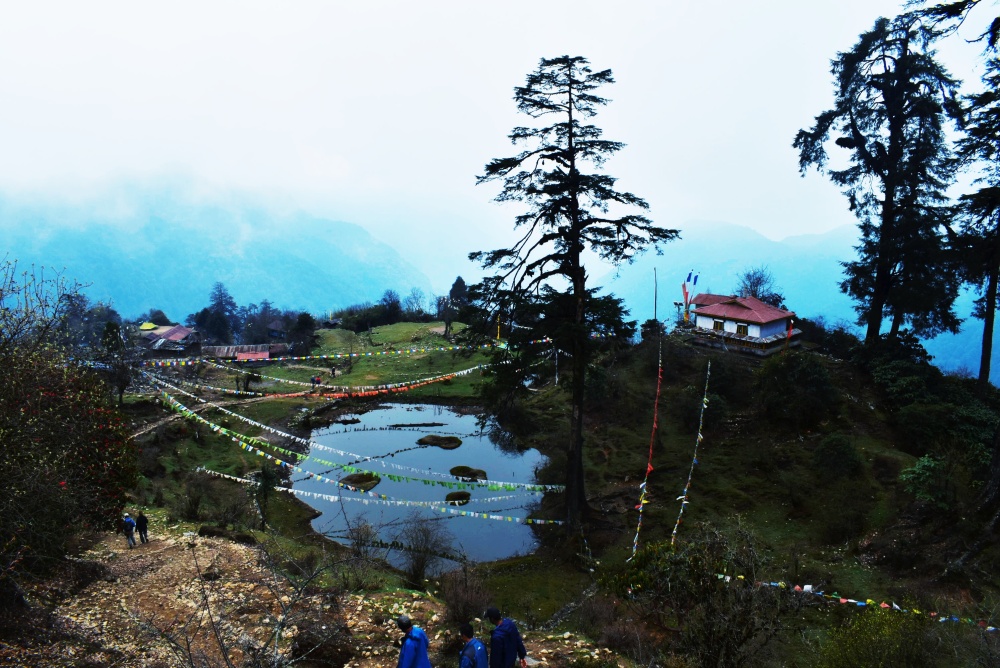
On climbing further our trail was now all lined with wooden planks preventing us from getting stuck in the sticky mud underneath. On our sides we were now sailing amid moss laden rhododendrons; sailing because without the rucksacks that was how the walk felt.

Post the climb we got some time to relax and enjoy the surroundings. Our course director Mr. Bhutia told us about the flora and fauna we’ll be observing. We got to know that the red rhododendron had medicinal properties and were called as rhododendron arboreum and that the pink ones were poisonous and were called rhododendron germania. And as we climb up towards the alpine range the rhododendrons would then be in form of these flowerless shrubs with medicinal properties.
Later after climbing down and having our lunch we had a session on hygiene and cleanliness .The sky was clear then and it felt good to feel the meadows and the fresh air . From then we were free to roam around. I went towards the abandoned monastery and the lake. I could see the colorful player flags waving in the wind and could feel the optimistic air wafting through me. It is believed that with the wind crossing the flags, the prayers and mantras will spread the peace and goodwill to the pervading space. I sat down beside the lake and could feel my breath being in unison with the bells ringing at a distance and with flags, with each waft of wind taking the flags towards and away from me. Later the large part of the evening was spent having coffee, momos and wai wai at the cafe.
On Day 12 we resumed our journey and were to trek till Dzongri (13,500 ft) which was at a distance of some 8-10 km. The trek is continuously uphill, with bit if a downhill just before the the halt for the day. Till Phedang the trail is dominated entirely by rhododendrons and post that with fir trees. As we reach near the alpine range the flora is dominated mostly by flowerless rhododendron bushes. On the trek towards the later part, we saw the first snow of the trail. Dzongri brings about a number of changes with it. There were no more green meadows and we had left the tree line far behind us. Now it was mostly the rocky patches that we could see. Also the days of dry toilets had started.

Post lunch, we were in search of coffee again and this time the super cozy cafe cum kitchen was just next to our hut. In the center of the room there were two large pots kept over a chulha like arrangement and around that were beds where we sat holding our freshly brewed cups of coffee, listening to the glories and dangers of climbing Mount Everest from personal account of our instructors. In the backdrop there were 60s-70s hindi songs playing and to me the whole universe just felt to be in Harmony there. That setup was the humblest of arrangements one can imagine but the essence of enjoying a hot cup of drink there remains unmatched.
Later, sticking to the “climb high, sleep low” funda we were taken some 1000 ft high till Dzongri top. Mid way we encountered our first hailstorm and soon the valley was entirely engulfed in thick layer of white. The complete route was now full of snow and the place of our halt had become completely unrecognizable as the dry soil that could be seen some minutes ago was now all hidden under whiteness. It was evening when we come back and had some more cups of coffee followed by dinner and a good sleep.

With Day 13th, arrived the final day of our climb to the base camp at a height of 14,600 ft. The total distance was around 12 km. The trek had a comfortable gradient and the amount of snow encountered depends upon the snow fall. Weather supported us well for more than half of the journey. Even after all these positives I actually am clueless as to why I was sick tired of that particular trek. Till now we had covered greater gradients and longer distances and managed to keep walking amid rain and slippery mud but never felt anything like this. I somehow was highly demotivated. Till Chowri Chu ( river) things were still fine but post that I just wanted it all to end. May be because I was not very excited to be in snow for full 11 days (duration of our base camp stay).

After walking for some time after the halt at Chowri Chu few of us got lost and didn’t know in which direction to move next . By the time it had started to hailstorm. We had to wait for sometime till we could find somebody to guide us. From there every place was just snow and boulders and each step felt like ages.
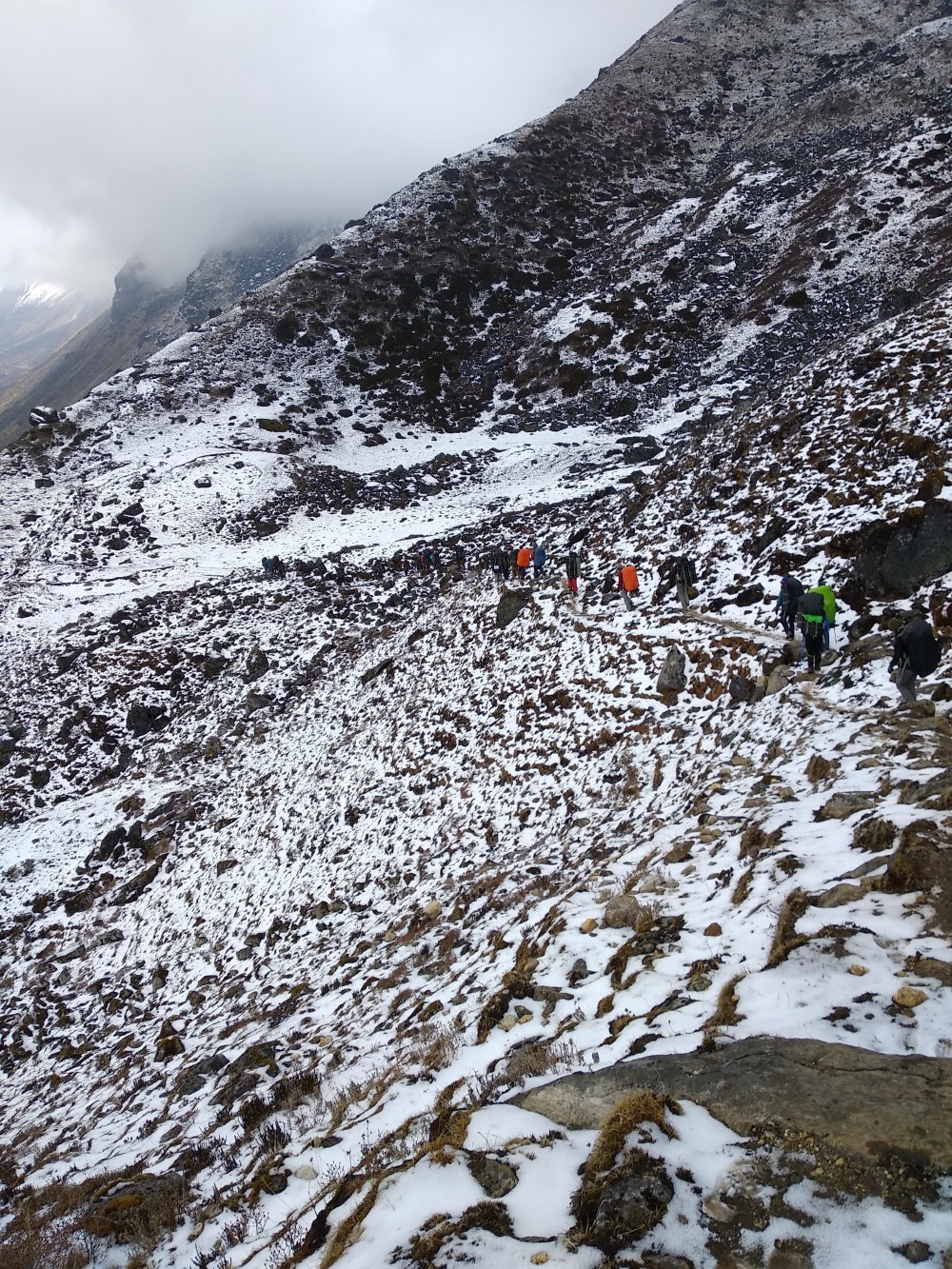
The shoulders by now were aching badly under the load of rucksack but it was mostly mental exhaustion which was taking the toll. We kept walking, keeping the destination on our mind. We couldn’t see the camp but we saw few people standing on the verge of the hill where we had the camp setup. It felt slightly better to have the destination in front of our eyes. The best part was AMC (Advanced Mountaineering Course) people welcoming us. A lot of them had come down to cheer us. Me being a big day dreamer, this was something I used to dream about – I’m up to something damn strenuous and people are cheering and clapping for me and as soon as I successfully finish it I get this warmest hug and some more cheers. And that’s what exactly happened. I can never forget the hug that this AMC girl gave me. It worked like a ‘jadu ki jhappi’. I was so out of breath and senses that I couldn’t thank her but will always have the warmest regards for the incident. Finally we were at the base camp and it was snowing sporadically. We were given accommodation in the wooden hut. All 25 girls in the same tent. It was a double decker arrangement with 2 wooden planks one above another.We all marked our territories by spreading our sleeping mat and arranged our things as the space permitted. I had stayed in tents but this kind of stay was first for me.
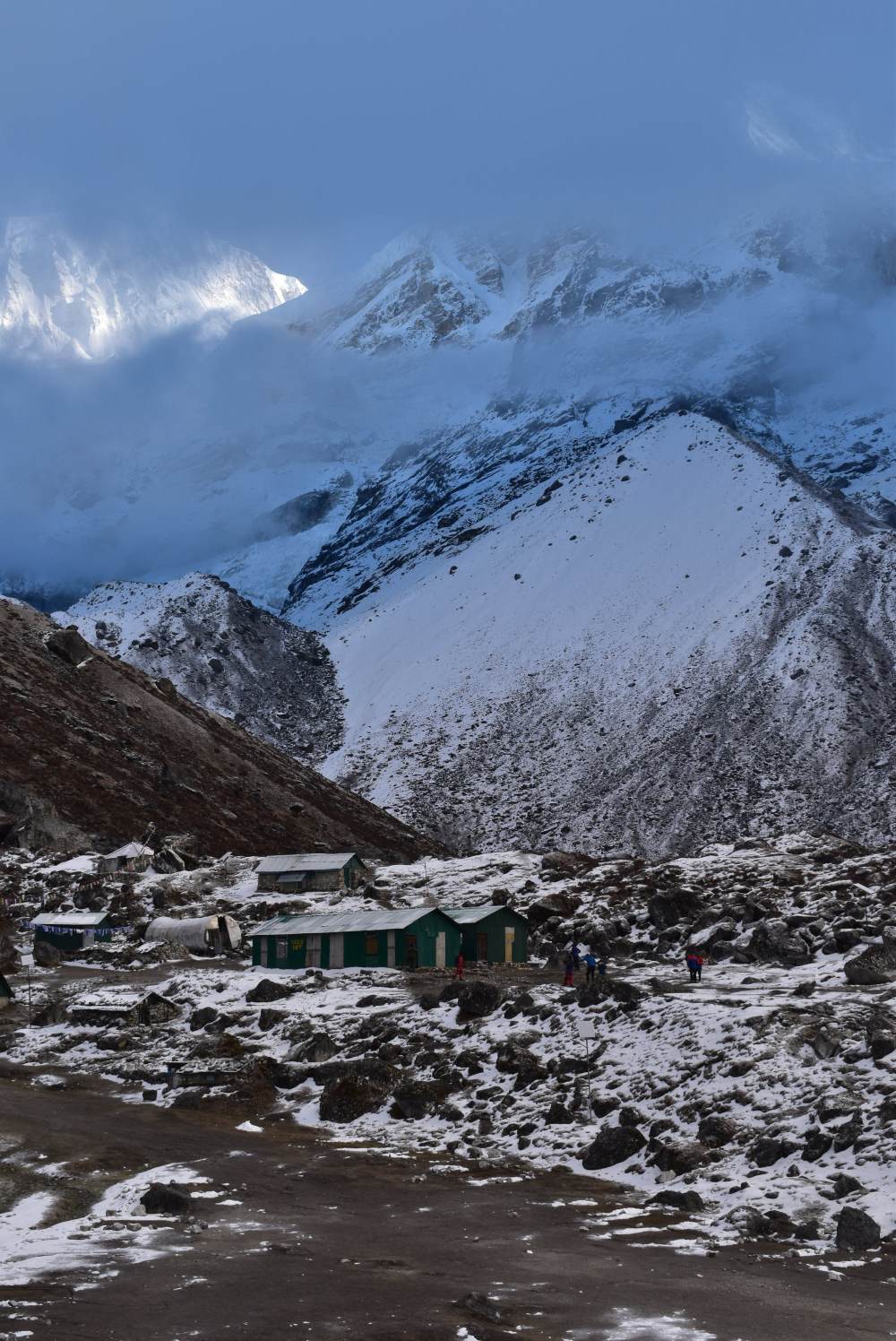
I was relieved to a good extent as there won’t be anymore struggling with the sleeping bag and packing stuff for coming 11 days but a bit of homesickness had started to creep in as well. My last phone call home was at Tshoka and it was going to be same for coming 2 weeks. And the snowfall, the chilling weather, no greenery had started to play its role in not a very positive way.
Previous – Part 1 – Days at HMI
Next – Part 3 – Days at base camp
Part 4 – The journey back and last few days at HMI